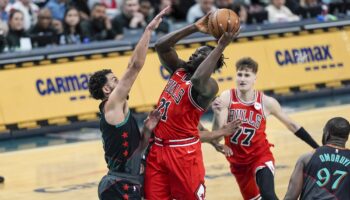 – by Adesina O. Koiki
– by Adesina O. Koiki
A Lot of Sports Talk editor-in-chief
PHILADELPHIA — As the Toronto Raptors witnessed later on in this extraordinary evening of playoff basketball, there are few situations in these 2018 NBA Playoffs that leave NBA teams with a helpless feeling more than LeBron James, ball in hand, attacking the opponent’s basket during crunch time.
The might of The King almost surely has a rival in the ability to strike fear into opponents during late-game situations, and the man who wields that power is the baby-faced tactician of the Boston Celtics, and instead of having the ball in his hands, all he has to do is bring his hands together for a split second.
When Brad Stevens calls timeout, especially in clutch situations, opponents better beware; A genius is at work.
Boston’s 101-98 overtime victory over the Philadelphia 76ers has put a sleeper hold on this series for the Celtics, going up three games to nothing, with the Celtics devising – and ruthlessly executing – some inspired, clever play-calling at the end both regulation time and in overtime. For all of the discussions about what has made Boston greater than the sum of its parts, and the undeniable role that Brad Stevens’ offensive system has played in it, it has been the continued late-game excellence, especially in after-timeout situations (ATOs), that already has the fifth-year NBA head coach in rarefied air when mentioning the best strategists in the league.
Celtics forward Al Horford, whose game-winning layup with 5.5 seconds remaining in the overtime after a perfectly-lobbed inbounds pass from Marcus Morris, gave Boston a 99-98 lead, was asked by ESPN sideline reporter Cassidy Hubbarth in the on-court interview if that quick-hitting play, coming after two successive timeouts, went as planned.
Of course it did, Horford intimated, and he placed that responsibility all on the shoulders – and mind – of his head coach.
“Brad [Stevens] is a genius, man,” Horford said. “Unbelievable. Sometimes he draws stuff up & I look at it & I go, ‘I don’t think…But no…'”
But yes. Stevens’ artistry on the whiteboard morphed into perfect execution on Horford’s game-winning layup, as Stevens took advantage of the 76ers switching every screen on inbounds plays – and did so perfectly. Three separate screens set by Celtics players inside of the arc on that particular side out of bounds lifted seven-footer Joel Embiid and 6-10 Ben Simmons, who both switched onto different players after those screens, away from the paint and above the three-point arc. That action left Horford guarded by Robert Covington in the paint, and the mismatch was created – and exploited.
Not surprisingly, what came immediately before that well-executed play? Another Brad Stevens timeout, and all that did was give the Celtics’ head man another chance to display his Xs-and-Os mastery.
“[The Sixers] had Embiid on Morris when he took it out the first time and then they switched him on to Al the next,” said Stevens in the postgame press conference. “They switched some screens and Al was able to seal for the little throw over the top. That’s something we’ve tried to do before. We were fortunate that Al made a strong catch, and made a very strong finish.”
By that moment, it had already been the second time that Stevens and the Celtics had bamboozled Philadelphia’s defense on an ATO, as Jaylen Brown’s layup with 24 seconds remaining in the fourth quarter had tied the score at 87. On that particular play, Brown, who was guarded by J.J. Redick in the left corner, came up to set a back pick at the free throw line on Ersan Ilyasova, who at the time was guarding Marcus Morris. As Redick switched onto Morris, Ilyasova was caught on the high side of Brown’s pick, leaving Brown with an open path to the basket. Jayson Tatum’s inbounds pass from the sideline found a cutting Brown, whose layup tied the score.
In describing the play, Brown’s explanation could not have been more straightforward.
“That’s a hell of a play call from Brad Stevens,” said the effusive Brown, choosing to call his head coach by his full name. “They had been switching all game, called a play, sealed the switch, scored a layup.”
It sounds so simple, yet the timeout that preceded it actually could have proved a detriment to Boston, as Stevens, while Boston was bringing the ball up the court after two Marco Belinelli free throws gave the Sixers an 87-85 lead, used a timeout when he thought his offensive set was stalling, even though he called the timeout as Horford was catching the ball in the post with J.J. Redick, a player five inches shorter, guarding him.
“If you have it in transition, sometimes, especially in the NBA, sometimes people stop because of the ability to advance the ball. They just think you’re going to [call timeout], so you can attack and see,” said Stevens. “You know, I was kicking myself a little bit when Al caught that ball in the post when I did call timeout because it was probably unlikely that we were going to get…we were going to get a pretty decent look with that because they weren’t going to leave our shooters.”
So a timeout called somewhat prematurely still ended up resulting in a wildly successful, momentum-changing play? That’s the power of Stevens’ timeouts!
No amount of time to draw up a play during a timeout could have prepared the teams for what happened following Brown’s layup, as a Redick turnover on the ensuing possession led to Terry Rozier finding Brown for another layup on a fast break with 1.7 seconds remaining, seemingly giving the Celtics the victory. Belinelli, however, came off of a screen and buried a corner jumper just inside of the arc to tie the game at the buzzer, though the confetti that was mistakenly set off would have had you believe that Belinelli’s shot was a game-winning three-pointer, not a two.
The exceedingly rare confetti-on-the-floor-while-getting-ready-for-overtime delay of an NBA playoff game was underway, though Stevens, using the timeout in between regulation and overtime – extended by the delay due to on-court cleanup – reminded his team that this is when and where his team thrives.
“No team is more built for having a disappointing end in regulation and then turning it around and winning it,” said Stevens. “I’ve never been around a group of guys, and I’ve been around some really special ones, that can just turn the page and play the next play the right way. It is a unique group in that regard.”
During the times when no possession can go to waste and when points may very well be the hardest to come by, the Celtics have made it look criminally easy over the past few years, and today’s repeated success almost belies the difficulties on those situations, traditionally, in the NBA Playoffs.
“We had two game-winning, game-tying buckets. Layups. That says it all,” said Brown. “We played hard, we fought, it was a tough environment. But when it came down to an ATO, draw up a big basket that we needed, and to get layups, I tip my hat off to Brad Stevens.”
The 2017-18 Boston Celtics continue to prove how unique it is, and the touch given to it by the genius on the sidelines is rapidly making this outfit a special one. All it took for that to develop during Stevens’ tenure was some time.
And some timeouts.




